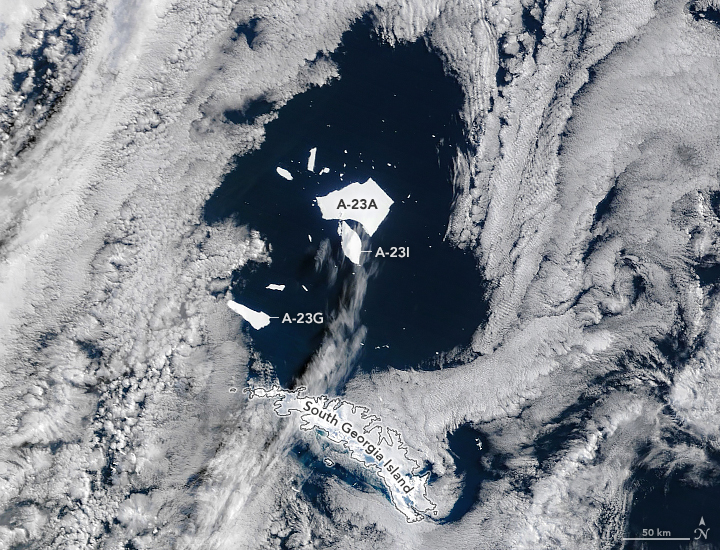Like every Antarctic iceberg that drifts north into the South Atlantic, Iceberg A-23A is surrendering to the ocean as spring arrives in the Southern Hemisphere. This breakup is notable, however, as it signals the imminent demise of one enormous, long-lived berg.
This image, captured on September 11, 2025, by the MODIS (Moderate Resolution Imaging Spectroradiometer) on NASA ’s Terra satellite, shows the ongoing disintegration of Iceberg A-23A. Its largest remaining fragment spanned just over 1,500 square kilometers (580 square miles)—still massive, and the world’s second-largest freely floating iceberg at that time. However, it had already lost about two-thirds of its area since it began drifting north from Antarctica several years earlier.
Nearby, large fragments that calved from A-23A—specifically Iceberg A-23G and Iceberg A-23I—spanned 324 square kilometers (125 square miles) and 344 square kilometers (133 square miles), respectively, at the time of this image. The U.S. National Ice Center names, tracks, and documents Antarctic icebergs with an area of at least 20 square nautical miles (69 square kilometers) or a length of at least 10 nautical miles (19 kilometers).
The icebergs were first identified in satellite data by Jan Lieser of Australia’s Bureau of Meteorology and Christopher Shuman of the University of Maryland (retired) and later confirmed by Britney Fajardo of the U.S. National Ice Center using imagery from MODIS.
“We can see and monitor these large icebergs—including A-23A and its named offspring—quite well with spaceborne sensors,” Lieser said. However, he noted that these behemoths often shed thousands of small- to medium-sized icebergs that can drift far from their source and into shipping lanes.
The Landsat satellites can observe some of these smaller icy fragments when weather permits, as can synthetic aperture radar (SAR) systems, which “see” icebergs during the polar night and in all weather conditions. Instruments like these provide less frequent but higher-resolution imagery that complements daily observations from MODIS on the Terra and Aqua satellites.
Before Iceberg A-23A began disintegrating, it survived a long journey of starts and stops. After breaking from the Filchner Ice Shelf in 1986, it lodged on the seafloor of the southern Weddell Sea for decades. It finally broke free in the early 2020s and began drifting northward. In March 2024, it was caught in a rotating ocean vortex in the Drake Passage, only to spin out and become lodged again—this time on the shallow coastal shelf south of South Georgia Island in May 2025.
After freeing itself once more, the iceberg drifted to its current location north of the island on what might be its final ride. Like so many other large bergs that have ventured into “iceberg alley,” it will eventually succumb to the relentless effects of warmer air and water.
NASA Earth Observatory image by Michala Garrison, using MODIS data from NASA EOSDIS LANCE and GIBS/Worldview. Story by Kathryn Hansen.

